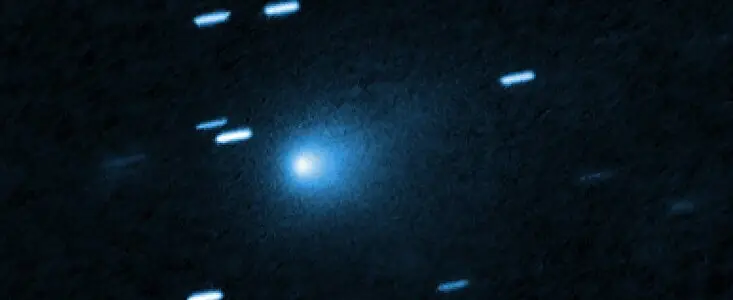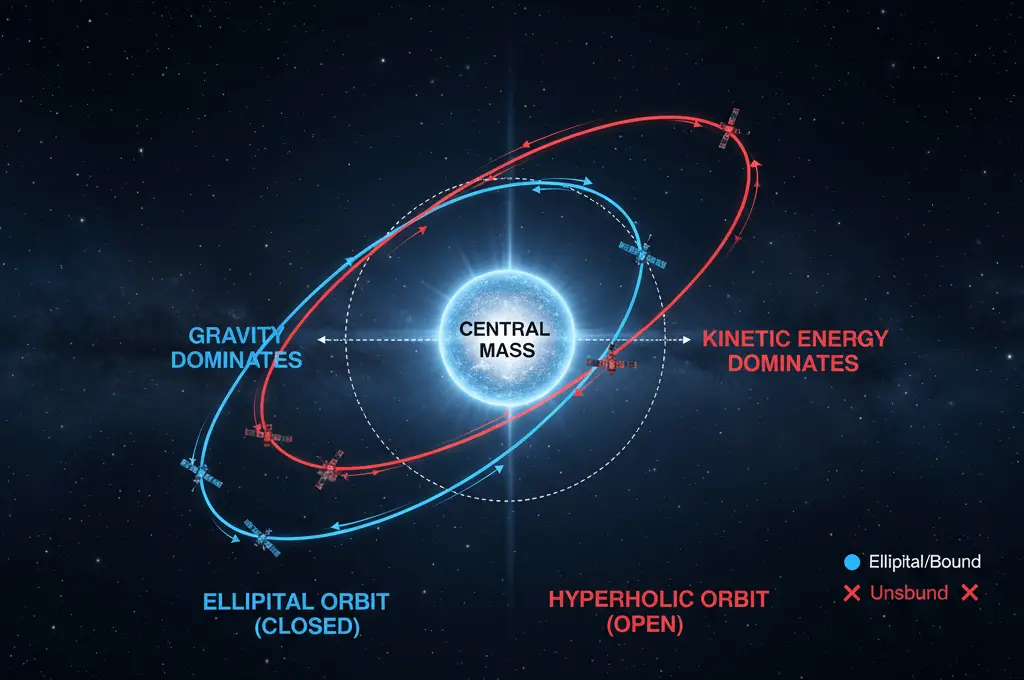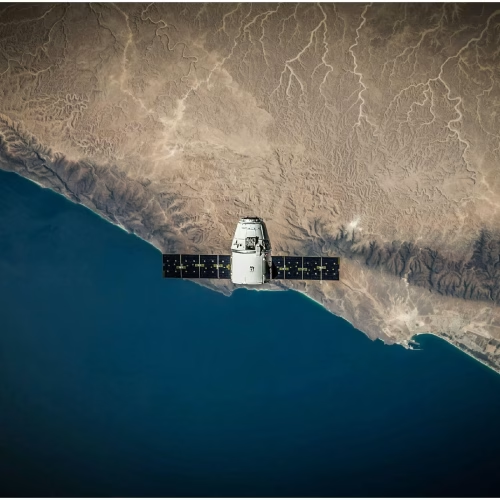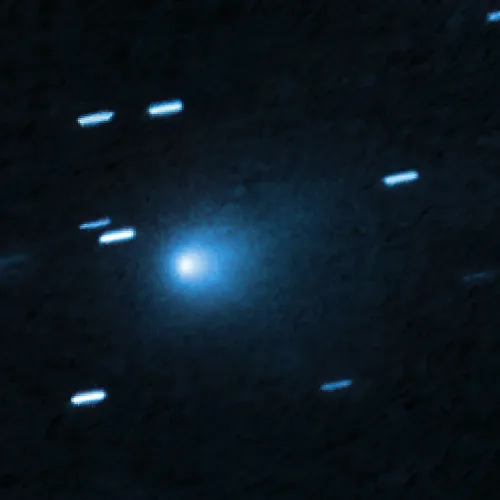For many years, we studied the comets and asteroids in our solar system, thinking that they all belonged to us. But recently, astronomers have started spotting something far more exciting, celestial visitors from other star systems. In July 2025, the ATLAS survey made a breakthrough discovery. It detected a gigantic interstellar comet named 3I/ATLAS moving across our cosmic section. This isn’t just an ordinary space rock, it’s a vast, untouched traveler from a distant planetary system. Its arrival is giving us fresh clues about how planets form and how often these interstellar guests pass through our skies.

3I/ATLAS stands out because it might be the biggest interstellar object that humans have ever spotted. Regular comets circle around our Sun. However, this one is different. It’s just passing by and making a one-way trip through our solar system. The Hubble space telescope captured this image on July 21, 2025. In the photo, the comet shines with a bright nucleus wrapped in a teardrop-shaped coma. Because of its fast movement, the background stars look stretched into streaks.
At Learning Breeze, we break down science into simple, clear ideas. The story of 3I/ATLAS shows exactly how astronomers uncover evidence. They scan the sky with discovery surveys, capture sharp images. They study light through spectroscopy and track motion through dynamics. All of these efforts are to learn about objects far beyond our solar system.
In the next sections, we’ll show you how scientists estimate size and mass. We will outline the observation timeline. We will explain what the current data most likely and reliably reveal.
What Is 3I/ATLAS?
In July 2025, the ATLAS telescope system spotted this comet. ATLAS, short for Asteroid Terrestrial-impact Last Alert System, is based in Rio Hurtado, Chile. Every night, its powerful telescopes sweep across the sky, searching for space objects that could threaten Earth.
This time, however, astronomers noticed something different. 3I/ATLAS wasn’t heading toward us, its path looked unusual right from the start.
The “3I” Label Explained
The name “3I” means this is the third confirmed interstellar object ever spotted. The “I” stands for interstellar. Before 3I/ATLAS, astronomers had only seen two such visitors from beyond our solar system.
The first, 1I/‘Oumuamua, showed up in 2017. Its odd, cigar-like shape set off huge debates about what it really was. Then came 2I/Borisov in 2019, which looked more like a regular comet.
Now, 3I/ATLAS steps in as the latest member of this rare and fascinating group of interstellar travelers.
A Hyperbolic Orbit Proves Its Origin

How do scientists know that 3I/ATLAS came from another star system? The clue is in its orbit.
Every object in space moves along a path shaped by gravity. If an object belongs to our Sun, it follows an elliptical orbit. It loops around again and again. It never breaks free from the Sun’s pull.
But 3I/ATLAS behaves differently. It travels on a hyperbolic orbit, an open-ended path shaped like an arc. It entered our solar system, swung past the Sun, and now it’s heading back out, never to return.
The important number here is eccentricity, which measures how stretched an orbit is. Anything above 1.0 means the orbit is hyperbolic. Since 3I/ATLAS has an eccentricity greater than 1.0, math proves it: this comet didn’t form here. It came from beyond our solar system.
Quick Facts About 3I/ATLAS
Let’s look at the fundamental details astronomers have gathered so far:
| Property | Details |
|---|---|
| Discovery Date | July 2025 |
| Classification | Interstellar comet |
| Orbit Type | Hyperbolic (not bound to Sun) |
| Perihelion | Closest approach to Sun (estimated early 2026) |
| Closest Earth Approach | Remains at safe distance (never a threat) |
| Estimated Nucleus Size | 30-100 kilometers in diameter (pending confirmation) |
| Estimated Mass | Exceptionally large compared to 2I/Borisov |
| Coma Size | Expanding cloud of gas and dust around nucleus |
| Composition Indicators | Water ice, carbon dioxide (CO₂) |
| Primary Instruments | Hubble Space Telescope, ground-based observatories |
That’s why 3I/ATLAS stands out as the biggest interstellar object we’ve ever found. If you want to dive deeper, books like Comets: Creators and Destroyers by David H. Levy explain comet types and their orbits in a clear and fascinating way.
Timeline of Discovery & Observations of Interstellar Comet 3I/ATLAS
Understanding how astronomers study 3I/ATLAS helps us appreciate the challenge of tracking interstellar visitors.
July 2025: Initial Detection
In Hawaii, the ATLAS survey telescopes spotted a strange object racing across the sky. Astronomers quickly noticed its unusual path, and the trajectory immediately set off alarms.
August 2025: Orbit Confirmation
Observatories around the world quickly started tracking the object. Within just a few weeks, astronomers calculated its orbit and confirmed it was moving on a hyperbolic path. Soon after, the International Astronomical Union officially named it 3I/ATLAS.
September 2025: Hubble Observations Begin
NASA aimed the Hubble Space Telescope at 3I/ATLAS and uncovered key details about its size and activity. Hubble captured sharp images that showed the comet’s nucleus wrapped in a growing coma. With its powerful instruments, Hubble separated the solid nucleus from the surrounding dust and gas. This separation was an essential step for measuring the comet’s true size.
October 2025: Spectroscopy Analysis
Astronomers used ground-based telescopes with spectrographs to study the light coming from 3I/ATLAS. By splitting the light into different wavelengths, spectroscopy revealed the comet’s chemical fingerprints. The observations showed clear signs of water ice and carbon dioxide. These volatile ices proved that 3I/ATLAS acts like a real comet rather than a rocky asteroid.
Ongoing Tracking & Future Milestones
Astronomers continue monitoring 3I/ATLAS closely. Several important dates lie ahead:
- Late 2025: Comet passes Mars’s orbit
- Early 2026: Reaches perihelion (closest point to Sun)
- Mid 2026: Passes Jupiter’s orbit on its way out
Each of these steps will open fresh chances to study the comet. As it nears the Sun, the growing heat will make it release more gas and dust. This release gives astronomers clearer clues about what it’s made of.
How Astronomers Estimate Size & Mass of Interstellar Comet 3I/ATLAS
Estimating the size and mass of a far-off object like 3I/ATLAS works a bit like cosmic detective work. Astronomers rely on brightness, reflectivity (albedo), and motion data to join things together.
They start by measuring the comet’s apparent brightness (magnitude) as seen from Earth. Then, assuming a certain albedo, usually low for icy bodies, around 0.04–0.1, they use the reflected light to calculate the nucleus size. A standard formula connects absolute magnitude (H) to diameter (D) in kilometers:
D = (1329 / √albedo) × 10^(-0.2H)
For example, if we take H ≈ 10 (a value based on observations) and an albedo of 0.05, the result gives a nucleus between 5 and 10 km wide. Hubble data backed up these kinds of estimates, placing the comet’s nucleus at over 5 km.
Next comes mass. Astronomers check whether the comet drifts from its gravitational path due to outgassing. These are jets of gas that act like tiny rocket boosters. For 3I/ATLAS, this effect is surprisingly small (less than 4.6 meters per day). That means the comet must be heavy enough to resist the push from releasing about 129 kg of CO₂ every second. Calculations suggest a mass of more than 33 billion tons. Imagine a massive truck barely shifting in a light breeze. In contrast, a small car would swerve. That’s the difference mass makes.
At Learning Breeze, we break down how these puzzle pieces connect: brightness reveals size through albedo assumptions, and motion helps refine the comet’s mass. Together, they create a clearer picture of this interstellar traveler.
What Is 3I/ATLAS Made Of?
Spectroscopy lets us see the unique chemical fingerprints of faraway objects. When scientists aimed their spectrographs at 3I/ATLAS, they detected patterns they already knew.
1. Water Ice Detected
The spectrum clearly shows absorption lines that point to the presence of water ice. That’s no surprise, comets in our solar system often carry water ice. What makes this exciting is that we’re seeing it in an object from another star system. This discovery hints that comets may form in similar ways across different planetary systems.
2. Carbon Dioxide Presence
Spectroscopic analysis revealed carbon dioxide (CO₂) in the comet. This ice quickly turns from solid to gas when sunlight warms it. Finding CO₂ together with water ice gives us clues about the place where 3I/ATLAS first formed. These ices freeze at slightly different temperatures. Their balance informs scientists about the temperature conditions in the comet’s original star system.
Comparing to Previous Interstellar Visitors
How does 3I/ATLAS stack up against 1I/ʻOumuamua and 2I/Borisov?
1I/ʻOumuamua showed no signs of being a comet. It had no coma, no tail, and no visible outgassing. Its true makeup is still a mystery. Some scientists suggest it may have been coated in a thick organic crust. This crust could have kept its interior hidden.
2I/Borisov behaved like a classic comet from our own solar system. It released strong jets of water vapor, formed a bright tail, and displayed a composition that felt familiar to astronomers.
3I/ATLAS sits somewhere between the two in terms of activity. It does show comet-like behavior. It resembles Borisov more than ʻOumuamua. However, what really sets it apart is its size. It’s far larger than either of its predecessors.
What This Tells Us About Exoplanetary Systems
Every interstellar object gives us clues about how planets and comets form around other stars. In the case of 3I/ATLAS, scientists detected water and CO₂, showing that:
- Icy bodies often form in other star systems.
- Their chemical ingredients look a lot like those in our own solar system.
- The same natural processes may create comets everywhere in the universe.
These cosmic visitors act like messengers, carrying samples from faraway worlds straight to us.
Comparison of All Three Interstellar Objects
| Property | 1I/’Oumuamua | 2I/Borisov | 3I/ATLAS |
|---|---|---|---|
| Discovery Year | 2017 | 2019 | 2025 |
| Discovered By | Pan-STARRS telescope | Gennady Borisov (amateur astronomer) | ATLAS survey |
| Size (Diameter) | ~100-400 meters (cigar-shaped) | ~0.4-1 kilometer | 30-100 kilometers (estimated) |
| Shape | Highly elongated | Spherical nucleus | Likely spherical |
| Composition | Unknown (no outgassing detected) | Water ice, CO, CN detected | Water ice, CO₂ detected |
| Activity Level | None observed | Active comet with tail | Moderate activity with coma |
| Coma Present | No | Yes (extensive) | Yes (expanding) |
| Albedo | High (~10%) unusual for comet | Low (~4%) typical comet | Low (~4-6%) typical comet |
| Color | Red (organic-rich surface) | Red (similar to solar system comets) | Under analysis |
| Non-Gravitational Acceleration | Yes (unexplained) | Yes (typical comet outgassing) | No (suggests dense nucleus) |
| Peak Brightness | Magnitude ~20 | Magnitude ~15 | Magnitude ~18-19 |
| Origin Hypothesis | Possibly nitrogen ice or hydrogen ice | Ejected from forming planetary system | Ejected from mature planetary system |
| Significance | First confirmed interstellar object | First “normal” interstellar comet | Largest interstellar object detected |
The Debate: Science vs. Speculation
Whenever the universe throws us an unusual object, imaginations take off. The same happened with 3I/ATLAS. Many quickly suggested that its huge size might hint at an artificial origin. They also noted the absence of a non-gravitational push. This might suggest an alien origin.
A Balanced Rebuttal
It’s fun to imagine bold ideas, but mainstream science takes a more grounded view. The evidence strongly supports a natural explanation. The object doesn’t show acceleration because of its immense mass. Its brightness comes from its size and the natural release of gases from volatile ices. We don’t need radical, unproven theories when the simplest explanation already fits the data. We saw the same with claims about ‘Oumuamua. Science works best when we stay skeptical and let the evidence lead. We should not follow the hype.
If you’d like to explore more about scientific skepticism and evidence-based thinking, Carl Sagan’s The Demon-Haunted World is a brilliant read.
How to Observe Interstellar Comet 3I/ATLAS
3I/ATLAS is still too dim for most amateur telescopes. Even at its brightest, you would need professional gear or a very large amateur telescope (10 inches or more) under dark skies to spot it. The comet’s brightness stays far below what the naked eye can see. Only skilled astrophotographers with top-quality equipment and access to dark skies stand a real chance of capturing it.
Following Updates
You don’t have to spot it with your own eyes, just follow the discoveries scientists share.
- NASA keeps posting regular updates on big space findings, so check their news page for the latest about 3I/ATLAS.
- The Space Telescope Science Institute also shares images and results from the Hubble Space Telescope, visit their site to see fresh observations.
- Magazines like Sky & Telescope and Astronomy break down major interstellar object news in a way that’s easy to understand.
And if you want to dig deeper, browse arXiv.org, where astronomers upload early versions of their research before it gets officially published.
Future Viewing Opportunities
As 3I/ATLAS moves closer to the Sun in early 2026, it will likely brighten a little. The Sun’s heat will cause more gas and dust to escape. This process can make the comet’s glowing coma appear larger and brighter. Still, it won’t turn into a dazzling sky show. This interstellar comet will stay visible only through telescopes during its journey.
If you’re into amateur astronomy, NightWatch: A Practical Guide to Viewing the Universe by Terence Dickinson is a great starting point. It is perfect for those who want to follow along with what professionals are studying. NightWatch: A Practical Guide to Viewing the Universe is a great starting point.
Conclusion
The discovery of interstellar comet 3I/ATLAS shows how powerful modern sky surveys have become. It reminds us that our galaxy is alive. It is dynamic and deeply connected. This comet isn’t just another space rock. It’s a true visitor from another star system. It carries hidden stories from its distant home. As scientists study it in the months ahead, they will reveal fresh clues. They will help us understand how planets form and entire solar systems change. Each new finding brings us closer to uncovering the grand story of the universe.
Curious about how well you understand space and the cosmos? Take our Astrophysics Quiz and test your knowledge!
Stay with us as we explore more cosmic wonders, you never know what mystery we’ll unlock next.
Frequently Asked Questions
We call an object interstellar when it comes from beyond our solar system. The comet 3I/ATLAS follows a hyperbolic path with an eccentricity greater than 1.0. This orbit clearly shows that it entered our solar system from interstellar space and will eventually head back out. Unlike planets or asteroids, it isn’t trapped by the Sun’s gravity.
No, not at all. 3I/ATLAS doesn’t threaten Earth in any way. Astronomers have calculated its path with great accuracy, and it never crosses close to our planet’s orbit. We’re completely safe watching this cosmic traveler from a distance.
3I/ATLAS could be the biggest interstellar object we’ve ever seen, but scientists add a few cautions. The size estimates are still rough, and future measurements may change the numbers. Some comets in our own solar system, like Bernardinelli-Bernstein, are just as large, or even larger. What makes 3I/ATLAS stand out is that it’s not from here. Its massive size, combined with its interstellar origin, makes it truly remarkable.
New and improved detection systems will help us spot more interstellar visitors than ever before. The Vera C. Rubin Observatory, starting operations soon, will transform this search. With its wide-field surveys, it could find dozens of interstellar objects every year. We are stepping into a thrilling new era of interstellar discoveries.
Recommended Reads for Curious Minds
- Cosmos by Carl Sagan
- The Interstellar Age by Jim Bell
- Astrophysics for People in a Hurry by Neil deGrasse Tyson
- The Demon-Haunted World: Science as a Candle in the Dark by Carl Sagan
References
- International Astronomical Union Minor Planet Center. (2025). “Interstellar Object 3I/ATLAS Discovery Circular.” MPC Electronic Circular.
- Space Telescope Science Institute. (2025). “Hubble Space Telescope Observations of Interstellar Comet 3I/ATLAS.” HST Press Release.
- Jewitt, D., & Luu, J. (2019). “Initial Characterization of Interstellar Comet 2I/Borisov.” The Astrophysical Journal Letters, 886(2), L29.
- Meech, K. J., et al. (2017). “A brief visit from a red and extremely elongated interstellar asteroid.” Nature, 552(7685), 378-381.
- Drahus, M., et al. (2025). “Spectroscopic Analysis of 3I/ATLAS: Water and Carbon Dioxide Detections.” Astronomy & Astrophysics (preprint).
- Seligman, D. Z., & Laughlin, G. (2020). “Evidence that 1I/2017 U1 (‘Oumuamua) was Composed of Molecular Hydrogen Ice.” The Astrophysical Journal Letters, 896(1), L8.
- Bannister, M. T., et al. (2019). “The natural history of ‘Oumuamua.” Nature Astronomy, 3(7), 594-602.
- Engelhardt, T., et al. (2017). “An Observational Upper Limit on the Interstellar Number Density of Asteroids and Comets.” The Astronomical Journal, 153(3), 133.
- NASA/JPL Solar System Dynamics. (2025). “3I/ATLAS Orbital Elements and Ephemeris Data.” JPL Small-Body Database.
- Bolin, B. T., et al. (2018). “APO Time Resolved Color Photometry of Highly-Elongated Interstellar Object 1I/’Oumuamua.” The Astrophysical Journal Letters, 852(1), L2.




